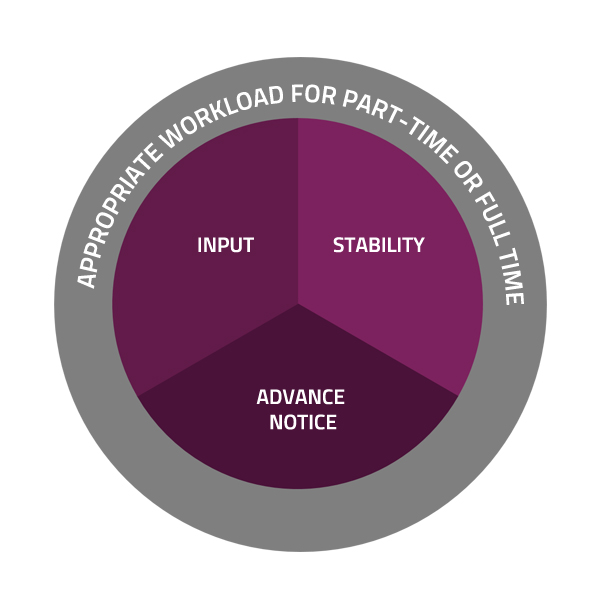

Shift-based environments often have specific operating constraints which make it harder for employers to facilitate work-life balance. So we’ve developed a new set of principles to help employers design working practices that give their staff more control – and reap the rewards.

Over the years, as we’ve been working to bring about more, better flexible working, we have created a core set of principles on which successful flexible job design should be based. As a top line – though of course, it’s a far more in-depth process – this involves looking at where, when and how much people want or need to work, and using this as a base to create roles which suit both employers and employees.
But when it comes to shift-based environments, such as retail, healthcare, warehousing or hospitality, these variables can’t be applied in the same way. The where is often a fixed location – a hospital, for example, or a restaurant. The how much is often problematic because of the low wages associated with many of these roles; for some, a part-time minimum wage isn’t enough to get by. And the when can be too driven by the employer’s requirements – such as needing a full, balanced team to cover each shift – to take employee needs into account.
Does that mean it’s impossible to deliver a good work-life balance for shift-based employees? No. But it does mean we need a different set of principles, and a different way of talking about flexible working, from which to build the change process. So here it is.
Drawing on the work of USA-based academic Sue Lambert, as well as our work in tough-to-crack sectors, we have identified the principles which improve work-life balance for shift workers in the UK. And we’ve used them as a basis for a Shift-Life Balance model for the home market.

Shift-Life Balance: a model for change
The first, overarching principle is about the size and volume of work: does the individual want to work full-time or part-time? Once this has been defined, employers then need to consider:
The aim of these principles is to help employees manage their responsibilities outside of work, make plans and organise the rest of their lives.
Of course, as with all types of flexible job design, identifying the principles that make up this Shift-Life Balance model is just the beginning. The extent to which an employer is willing or able to tackle one or more of them will vary case by case.
And it’s not just a case of making a few tweaks. These principles are fundamental to the way that rosters and shift patterns are created. So any changes need to be tried and tested to ensure that they deliver. That’s where we come in.
We are already using this model in a range of pilots which we’re carrying out through our Innovation Unit, from nursing and retail to teaching, and we’ll share the outcomes as they develop. If you’d be interested in hearing more about what we’re doing, or supporting one of our projects, do please get in touch.
In shift-based environments, the structures and cultures we need to tackle are deeply-embedded, and in some cases, resistant to change. That’s why this work hasn’t been done already – and why it needs the level of expertise that our Innovation Unit can bring.
But if we don’t tackle these challenging sectors, and flexible working remains a white-collar, office-based privilege, what will the impact be? Put simply, we’ll be failing the millions of employees, often in lower paid jobs, who are struggling to balance their work and home lives. And these jobs matter – not just to the people who work in them, but to all of us.
For example, there are an estimated 40,000 nursing vacancies in the UK; the lack of flexible working options has been identified as one of the reasons. Similarly, the construction industry needs 157,000 new recruits by 2021 to keep up with demand. And more than 47,000 new secondary school teachers are needed over the next six years. In total, 5.5 million workers in the UK work shifts – that’s a sixth of the working population.
Workers in these sectors need predictability and control over when they work – just as much as those in office-based jobs. And employers need to find a way to make this happen if they are to motivate and engage their existing employees and, crucially, attract new ones. We believe we can crack these challenging sectors, and that’s why we’re rolling up our sleeves and getting on with this complex work. It’s a prize worth aiming for, for all of us.
Published February 2019